Fresh Ground Flour and Home Milling
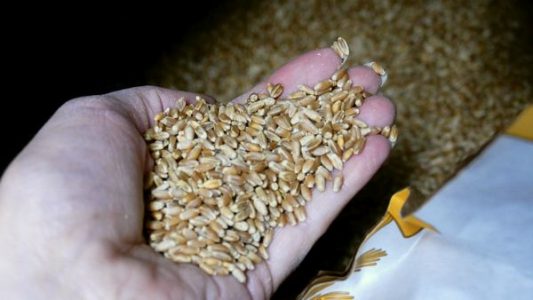

I have two home mills, the Blendtec Kitchen Mill and the Mockmill, well maybe three if you count the cheapo coffee grinder I used in the past before I got the Mockmill.
The Blendtec Kitchen Mill has been a mainstay in my kitchen for years. I’m actually on my second one as the first one ended up with a cracked housing (it was old, I bought it used on Ebay, years ago). I like that this mill will grind fine flour fast and in a large quantity (well large for the home baker). However, that’s pretty much all it will do, just flour. It will do a variation of super fine flour to less fine flour. It won’t grind cracked meal, bulgher, coarse meal etc. One of the cons is that it is veryLOUD! Sounds like a jet engine! So don’t forget your earplugs!
That’s when I get out my Mockmill. However, I’ve found that even when you want a super fine flour, the Mockmill steps right up to the plate and delivers. The only thing it doesn’t deliver is the “fast” part. It takes time with the Mockmill, but the grain doesn’t overheat either, which is a plus.
So it’s nice to have both of them, they complement each other. I would be totally willing to try out other mills if any of the company’s out there would like me to. 😉
Purchasing and Mixing Grains
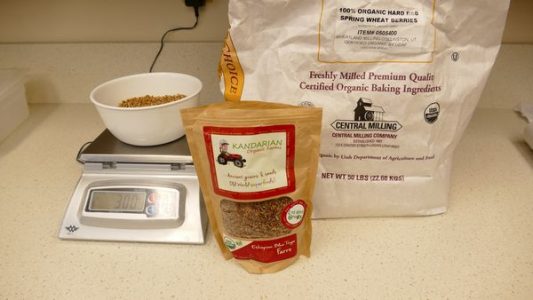
I recently bought 100 pounds of fresh whole wheat berries from Central Milling. I got the White Whole Wheat and the Red Spring Wheat, both of them are organic (50 pounds of each).
I am able to get fresh grain berries locally at a market in one of the nearby towns. I have some Spelt, Rye, Korashan (also known as the trademarked Kamut), Millet, Triticale, Einkorn, Teft, seeds, spices etc. all tucked away in Cambro containers.
I also had the chance to grind up some Ethiopian Blue Tinge Farro from Larry Kandarian Farms and some Yecora Rojo (both sent to me by Guy Frenkel). Larry Kandarian Farms is near where I grew up in California, I never knew they were there or I would have visited Larry and taken a tour of his farm (which I still hope to do next time I visit!).
I’ve enjoyed grinding my own grains for years (even cornmeal and rice flour). The smell and flavor of using freshly ground grains is similar to using freshly ground coffee instead of pre-ground, stale coffee in cans. Or it is similar to using fresh herbs instead of dried herbs. It makes a huge difference in flavor and aroma.
It’s great fun to mix different grains in a bake. Just select what you want and grind them all together. If you want to add seeds (especially toasted) to the flour, you can often grind them along with the grains but often seeds cannot be ground by themselves as they have too much oil and will gum up grinders meant for making flour. You can mix a toasted grain or a low protein grain with a higher protein grain or blend ancient grains for flavor and digestibility. Why not throw in some rye berries too? At brewery shops they carry grains that are smoked, toasted and have different flavors that you would never find in a regular store.
Check to see what grains are available locally and also to see if you are lucky enough to have any nearby mills. Then look online at the thousands of sites where you can purchase different grains, flour, seeds and spices.
Amy Halloran has a great list of mills from North America and Canada.
Green Flour
Some bakers worry about using “green” or freshly ground flour when they bake. I was concerned about it in the past because I did have some batches of dough that were “bucky” and let loose of the water during fermentation. So I wrote to King Arthur flour and found out that if you use freshly ground flour within about 8-10 hours of grinding, you shouldn’t have a problem, but if you grind it and use it the next day or a few days later, you might have a problem. The chemical change in the green (freshly ground) flour happens after about eight hours and then the flour needs to be aged (with oxygen) 2 – 3 weeks for it to stabilize again. It’s why mills in the past used porous flour bags, so the freshly ground flour could “breathe” while it aged.
The green flour issue isn’t a problem if you are only using a small portion of freshly ground flour in your dough. It can be a problem when you use larger amounts or 100% whole grain flour.
If you are a part of the group, Perfect Sourdough, on Facebook, you can find a a document in the file section where I copy and pasted the information I received from King Arthur Flour concerning green flour.
Sieving Flour
I do like to sieve my flour sometimes. The whole grain is very nice to use so as to gain all the nutritional attributes. However, sometimes using a sifted flour works better for some formulas where you want a loftier loaf or more open crumb. Children and invalids sometimes can benefit from sifted flour if they have a harder time digesting bran. I often will save the bran sifted from the flour and use it in other formulas or for dusting my bannetons.
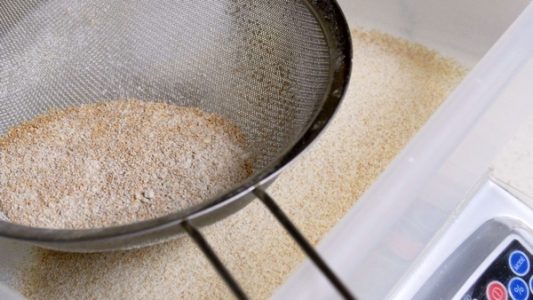
I’m still searching for a pro baker’s sieve. I haven’t had luck finding a nice quality one yet. I’m still using a kitchen sieve, which actually works pretty good.
Toasting Grains and Seeds
You can toast your cracked grains and seeds to add extra depth of flavor to your bread. I’ve toasted and added cracked grains and seeds to the dough or seeds to the outside of the crust. You don’t want large cracked grains on the outside of the crust as they can potentially break someone’s teeth.
Experiment with how much you can get away with before the amount inhibits the gluten formation, but you should be able to play with up to 10% pretty easily. For my mill grain loaves I mix many types of grain and seeds together to add texture and flavor to the loaf. It’s a favorite with most people.
Scalding Flour and Reusing Crumbs.
There is a very old method of adding to dough a portion of flour which has been scalded or boiled with a liquid, so that the starch is already gelatinized. It adds softness and sweetness to the loaf. This method is found under various names such as, scalded flour, roux, Hokkaido, Tangzhong water roux etc.
Sometimes bakers will grind up old loaves of bread, soak the crumbs and add the crumbs back to the next batch of bread. That is an old custom especially when baking rye breads and it is a good way to prevent waste. Of course bread crumbs can be used in various ways, too numerous to talk about here.
Sprouting Grains
Sprouting grains is a great way to add some enzyme activity to your loaves and nutrition as well. Grain is often sprouted just until the small rootlet appears or up until it is the length of the grain. Then it is either ground and added to dough in a moist state:
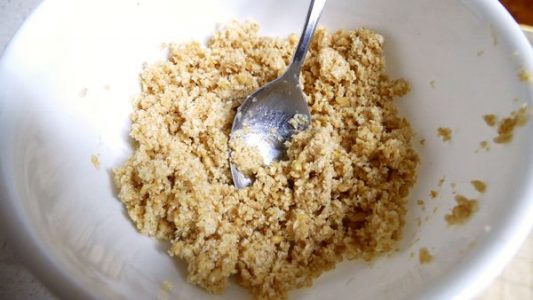
Or it is dried after sprouting and then ground up as a flour. Sometimes the flour will even be lightly toasted for flavor and/or to control the enzyme activity so there’s not too much. Sprouted grains are very nutritious and some people feel they are easier to digest.
Soaker or Mash of Cracked or Whole Grains
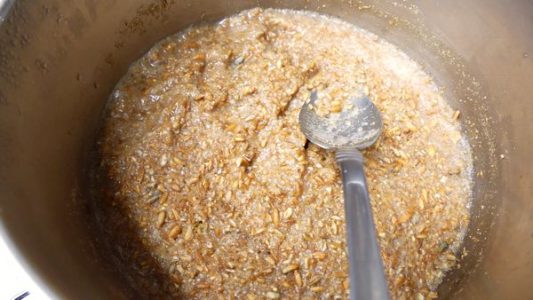
Whole grains can have a lot of enzyme activity, plus pytates and lectins as part of their makeup. Making a soaker or mash of the grains will help convert the starch to sugars, deactivate some of the enzymatic activity and get rid of some of the phytates and lectins in the grain. You can also add a pinch of salt to a soaker to help control excessive enzyme activity.
For a soaker you would either pour boiling water over the grains or toast them first and pour water over them(which comes to a boil), then allowing them to cool. In the case of using boiling water you would be mainly deactivating the enzymes, softening the bran and modifying the lectins and pytates so as to render the grains more digestible.
Sometimes the grains are just soaked at room temperature overnight or have some sourdough starter added to the soak to ferment overnight. In which case the enzymes and soaking help make the grains more digestible but there is not as much sweetness and breaking down of starch as in a mash.
A Mash would be (cracked) grains or a mixture of grains brought to a certain temperature and then cooled. Mashing is commonly used for making beers but the idea of the mash is to have the enzymes work to liberate the sugars from the grains so as to add some sweetness to the dough.
You can also add seeds to a soaker or mash if you like.
If you have a link to a local grain mill or great place to purchase grains online, please leave it in a comment below.
Happy Baking Everyone!
Teresa
Click here to find where to purchase the Blendtec.
Click here to find out where to purchase the Mockmill.
Many of the links in this article are affiliate links, some of the links are just for information or that I find interesting. Thank you!

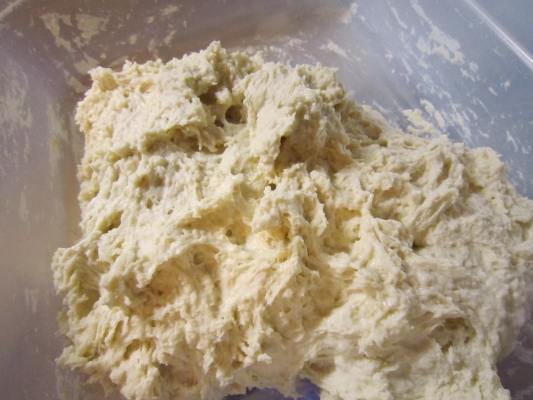
Andrew Ross recently noted that the idea of aging flours is applicable to white flours – but that using fresh milled “green” flours is not a concern.
I just got some white whole wheat grain. Could you point me to some of your favorite uses?
Hi Margie, you can substitute the white wheat for any of the formulas that call for whole wheat. You can usually substitute part whole wheat in most formulas that call for all white flour, start with 10-20% and then more. Remember you need to handle dough differently as it contains more whole grains and it will need more liquid, so adjust by feel. Look in the Skills section (Under Formulas) to get started on some whole grains using white wheat: https://thebakingnetwork.com/lessons/100-whole-wheat-sourdough-pan-loaf/
Here is the Skills section: https://thebakingnetwork.com/new-skills/
I have a Blentec blender and a Mockmill. Milling my own grains has really changed the game for me as far as a real earthy depth in flavor and healthy bakes!
Me too Couettes, I love the flavor and aroma of the freshly ground grains and knowing it’s a healthy for my family.